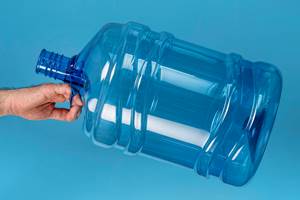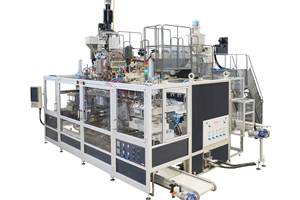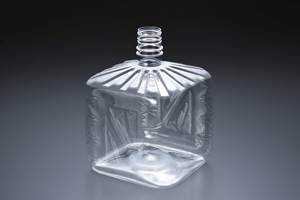The Next Revolution: All-Electric Blow Molding
The rapidly growing popularity of electric servo-motor drives in injection molding has cut their cost, creating the opportunity for even more rapid penetration in blow molding.
The rapidly growing popularity of electric servo-motor drives in injection molding has cut their cost, creating the opportunity for even more rapid penetration in blow molding. Movement in this direction is just getting started in North America. So far, only one of the 10 firms now supplying electric blow molders (or planning to do so) has sold any on this continent. Electra Form has supplied 40 all-electric PET reheat stretch-blow machines here since they were introduced in 1995. But in Japan, electric blow molding machines already account for 80% of sales, reports Norifumi Sahara, general manager of sales for Tahara Machinery Ltd., one of the earliest entrants in electric blow molding.
Advocates of all-electric machines point to several advantages over hydraulics: Energy savings, quietness, absence of messy hydraulic oil, more precise and repeatable mold positioning (within 50 microns, Tahara reports), faster cycle times, reduced downtime and labor, fewer and smaller mold-temperature controllers, and smaller footprint of the molding cell.
So far, lower prices of servo motors have created favorable economics mainly for smaller machines that blow mold bottles up to 5-liter size. All-electric units are currently offered in continuous-extrusion versions by JSW Plastics Machinery, Krupp's Fischer-W. Muller Div., Magic North America, and Tahara. In PET reheat machines, suppliers are American Plastics Technology, W. Amsler, Chumpower, Electra Form, Frontier, and Tahara. Many other suppliers are either evaluating the technology or taking a wait-and-see stance.
Electric-driven machines with two and four cavities are still more expensive than conventional hydraulically driven units of the same size. However, the price premium is narrower in this range than for models with more cavitation or larger mold capability. Suppliers say the price premium on all-electric models has fallen from about 30% five years ago to between 5% and 20% today. It remains closer to 30% for bigger machines requiring larger motors, which limits their chances in the market for the time being. For that reason, Davis-Standard Blow Molding Systems may scrub a project started two years ago to develop 8- and 10-lb accumulator heads with an AC servo-driven push-out.
However, some machine builders are bridging the price gap on larger machines by offering "hybrid" models that combine hydraulics with electric motors. This approach improves energy efficiency somewhat while keeping the machines more affordable.
Why go all-electric?
Electric-machine proponents generally point to energy savings as their biggest advantage. Energy savings come from two sources: inherently higher efficiency of electric motors and the fact that electric motors operate only when needed, whereas hydraulic motors pump continuously and usually at a fixed speed.
Payback will probably depend on how much you pay for electricity. Japanese molders pay on average about three times more per kilowatt-hour than the U.S. average. But the payback in high-cost regions of the U.S. could be dramatic, too. Makers of electric blow molders say energy savings of 20-50% are common, although one firm pegged the savings as high as 85%.
Sources at Fischer-W. Muller say its twin-clamp electric units can reduce electricity consumption by 100,000 kwh/yr. That could be worth $3000 to $12,000, depending on location.
What's more, hydraulic oil requires cooling, which consumes more energy. A 20-40 ton chiller used for this purpose can now be eliminated, says Jack McGarry, national sales manager of Fischer-W. Muller, which licenses electric-machine technology from Tahara. "All that's needed is a 3-4 ton chiller for cooling the mold," he says, noting the added benefit of a smaller molding-cell footprint.
Electric servo drive can also help pay for itself through improved molding throughput, suppliers say. The reaction and positioning times during mold transport (on shuttle machines) and mold opening and closing are reportedly much faster than on hydraulic machines. JSW reports that its new model JEB-7 II continuous-extrusion shuttle unit can save 39% in dry-cycle time through faster clamp movements. McGarry of Fischer-W. Muller agrees: "Dry-cycle time can be up to 20% faster due to the control improvements on the electric machine. We can get dry cycles of less than 1.8 sec vs. 3 sec with hydraulic units."
American Plastics Technologies president Rao Murukurthy also claims higher speed for electric machines. He expects the APR-30PC, the firm's developmental electric continuous-extrusion machine, to mold 30-liter polycarbonate bottles on a 32-sec cycle, down from 45 sec for APT's current hydraulic machine.
Electric machines are said to excel in precision: "All movements executed by an electric drive are very accurate and 99.98% repeatable," says McGarry. Advocates say the programmability and position-feedback capability of an electric motor permits much tighter control than compressible hydraulic oil. "The repeatability of an electric motor exceeds what you can do even with closed-loop hydraulics," says Tom Cameron, technical manager of Magic North America. In fact, electric-machine control is so precise that set-up requires more exact plotting of positioning points, cautions Renzo Mueller, marketing manager at W. Amsler.
Well-maintained hydraulically driven machines can do a very good job, suppliers note, but their accuracy is prone to drift. "Hydraulic fluids are always under pressure and heat and can degrade over time, causing varnish to deposit on valves. The oil also can amass dirt that clogs lines, leading to a slower, less accurate response," says McGarry.
All-electric machines are quieter, too. Suppliers report that operating noise levels are at least 10 db lower than for similarly sized hydraulic units. JSW says its small extrusion blow molder runs at a peak level of about 75 db, while conventional hydraulic systems hit 85 db.
For continuous extrusion
Here's an overview of models currently available or in development for extrusion blow molding:
Fischer-W. Muller introduced at K'98 in Germany the first of two double-station shuttle electric models from its FMB1-D line. Computer-controlled servo drive provides speed and position control of a newly designed twin-platen toggle clamp. It has a "knuckle" that locks the clamp prior to building tonnage. Clamp force is adjustable up to 30 tons on the 2D model and 80 tons on the 4D. Tiebars guide the moving platens and keep them parallel.
A single servo drive and spindle perform horizontal transport of both clamp units to the blow position. Neck calibration is driven by a servo motor, which allows precise setting of speeds and stroke lengths. Another servo motor controls up-and-down rocking movement of the extruder head, which was developed by Tahara. That drive governs height adjustment of the head relative to the blow mold. Material is plasticated by a DC-driven 50- or 80-mm extruder. Fischer's BlowCommand3 monitors all process parameters.
JSW Plastics Machinery, which claims to have been first with an all-electric machine seven years ago, showed its new JEB-7 II extrusion blow machine at the recent IPF '99 show in Tokyo. The unit makes HDPE bottles up to 2L in one to four heads at throughput rates of 77 lb/hr. An AC motor drives a 25-point parison controller, and another operates the parison-cutting system. Changing the toggle system on the 7-ton tiebarless clamp to a vertical arrangement is said to improve platen parallelism. Also new is an electric mold-height adjustment device, ability to accommodate a wider range of mold thicknesses, improved blow-pin positioning capability, and more heater zones in the die head.
Magic North America rolled out its first all-electric machine, the Mini 100 D/E, at K'98. The compact unit makes 40-cc bottles with twin heads or 100-cc bottles with a single head. It has a 1.1-ton clamp and 0.8-sec dry cycle. It comes with a 38- or 50-mm extruder that puts out 48-70 lb/hr of HDPE or 30-53 lb/hr of PVC. Total installed power is 16 or 26 kw, depending on extruder, and average consumption is 9 or 14 kw. Specific energy consumption is claimed to be less than 0.25 kw/lb.
Tahara says it has sold around 200 electric machines in the past five years. It offers MSE and MB electric machines in four single- and double-station models with two to four cavities and clamps from 3.3 to 13.2 tons. AC servo drive reportedly enables the clamp to stop within 50 microns of preset position. The machine has rocking extruders. Tahara claims that a 7.7-ton electric model with a 55-mm extruder consumes only 10.8 kw to mold 410 half-liter HDPE bottles/hr. That compares with 21.9 kw to mold 340 bottles/hr on a hydraulic machine with the same size extruder.
Uniloy Milacron is developing its first all-electric continuous-extrusion machine at Uniloy's B&W unit in Berlin, Germany. The shuttle machine, set to debut at NPE in Chicago in June, will probably be sized for up to 5L containers.
For oriented PET
Stretch-blow molding has gone electric, but so far only in reheat machines:
W. Amsler Equipment's new L-22 two-cavity unit produces bottles from 200 cc to 2L at up to 2400 bottles/hr. Average energy consumption is 28 kw. Separate servo motors run the preform-transport device and the 27.5-ton clamp. The machine reportedly requires about 2-5 hp at a 3.5-sec cycle, versus about 30 hp plus 3 tons of cooling for a comparable hydraulic unit. A servo-electric motor drives platen movements. Clamp force is generated with blowing-air pressure.
Chumpower says it has sold 80 of its AC-motor and air-powered CPSB machines in Taiwan. (In this country, it is represented by General Equipment & Machinery Co.) These machines are designed to be flexible and low-cost. Mold changes reportedly can be performed in 30 min. These racetrack-style units come in models for making bottles from 0.25L to 5L in one to three cavities. Clamp forces range from 17.6 to 33 tons. Total installed power is 35-70 kw.
Electra Form offers RSB-1, RSB-2, and RSB-4 machines with one, two, and four molds, respectively. They produce bottles up to 2L at up to 1500/hr per cavity. Servo motors operate the preform racetrack and the toggle clamp (13.5 or 27 tons). The clamp is blowing-air-pressure compensated. Maximum drive power ranges from 8.4 to 12.9 kw.
Frontier's new BIO-F2 series of linear electric reheat machines boasts dry cycles of only 1.3 sec. The BIO-F4, designed for production of 1L bottles in four cavities, ran at the IPF '99 show on a 3-sec cycle (1200 bottles/hr/cavity). Frontier also offers models that make 2L bottles in four cavities, 3L in two cavities, and 0.5L in six cavities. Wide-mouth and hot-fill machine versions are also available. Total drive power is 0.8 kw.
Frontier also recently introduced the larger model EFB20-L designed to make up to 20-liter PET or PC containers one-up at 100 bottles/hr. It has a 46-ton pneumatic clamp with air-pressure compensation. Total motor power for the blower and preform rotation is 2.1 kw.
Tahara offers its CSB series of racetrack-style machines for producing 1L and 2L bottles at 900/hr in one cavity or 1800/hr in two cavities. More heat-resistant (75 C) bottles can be made at 650 or 1300/hr. The preform carrier, blow carrier, preform transfer, 16.5-ton clamp, and stretch pin are all driven by AC servo motors. Total installed drive power is 44 kw.
American Plastic Technologies is developing one- and two-cavity reheat units capable of producing 2L bottles at up to 1300 bottles/hr and 2400 bottles/hr, respectively. The servo-electric toggle press will require only 15% of the energy used by a hydraulic clamping system.
Hybrids for larger parts
For larger bottle sizes, new hybrid machines are said to give the precise and quick movements of an electric drive with the reduced expense of an hydraulic drive.
Fischer-W. Muller introduced the hybrid FMB2 series in 1997. Three models with clamps of 44, 66, and 88 tons can produce containers or technical parts from 30 to 220 liters using either an accumulator head or continuous-extrusion head. An electric servo-driven ball screw provides fast clamp movements to within 2 in. of closed position. Then clamping is achieved with a combination of hydromechanical locking cylinders on the tiebars and large ring-shaped, "pancake" hydraulic cylinders behind both platens. By next April, the company plans to convert its long-stroke FMB4 machine to hybrid clamping.
Graham Engineering's new GEC-4 (four-station) and GEC-Mighty 5 (five-station) rotary shuttle units make containers from 100 cc to 30 liters. These continuous-extrusion, indexing-wheel models use hydraulic cylinders to operate clamp open/close and shuttle functions. An electric servo motor powers indexing. Dry-cycle time per station is 2.5 sec. The Mighty 5 uses an accumulator head or continuous-extrusion head.
Related Content
Stretching the Boundaries of Large PET Containers
NPE2024: Cypet shows off new capabilities for its ISBM machines.
Read MoreSolve Four Common Problems in PET Stretch-Blow Molding
Here’s a quick guide to fixing four nettlesome problems in processing PET bottles.
Read MoreAll-Electric Machines & Blow Molding Automation Featured at K 2022
Magic MP spa will present new EBM auto adjustment, electric accumulator-head technology, a larger ISBM machine, a quick-mold-change system, and robotic product handling/palletizing at this month’s show in Düsseldorf.
Read MoreModified Machines to Mold Unusual PET & PP Bottles at K 2022
K 2022 visitors looking for new ideas in stretch-blown containers will be treated to two novel collapsible concepts a the Nissei ASB booth.
Read MoreRead Next
Making the Circular Economy a Reality
Driven by brand owner demands and new worldwide legislation, the entire supply chain is working toward the shift to circularity, with some evidence the circular economy has already begun.
Read MoreRecycling Partners Collaborate to Eliminate Production Scrap Waste at NPE2024
A collaboration between show organizer PLASTICS, recycler CPR and size reduction experts WEIMA and Conair will seek to recover and recycle 100% of the parts produced at the show.
Read More



























